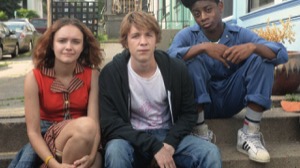
This year’s Sundance breakout Me and Earl and the Dying Girl is the latest in the curious string of films based on dark young adult novels: The Fault in Our Stars, If I Stay, The Spectacular Now, The Perks of Being a Wallflower, and, going back a bit, The Lovely Bones. As Gayle Forman, the writer of If I Stay, has said, teenagers yearn for stories about death and friendship. Considering how many adults are buying these books and, based on who I’m seeing in the theaters, seeing these films, older folks yearn for these stories, too, possibly as nostalgia for a time of simpler emotions, possibly because films about adults rarely focus on intricacies and dramatics of friendship. Me and Earl and the Dying Girl is clearly a story of adolescence and coming of age, but it works with universal themes of loyalty, forgiveness and grief. The film doesn’t say anything new about these things, but director Alfonso Gomez-Rejon and writer Jesse Andrews say them with an original voice, and that makes the eventual tears worth it.
The “Me” is Greg (Thomas Mann), a high school senior in Pittsburg who has studiously and blithely avoided joining any clique and refuses to even call the boy he’s spent all of his life hanging out with his friend. Instead, Earl (RJ Cyler), who is black and from a much poorer neighborhood, is Greg’s “coworker”; they make movies together, micro-budgeted, rather brilliant parodies of classics with titles like Eyes Wide Butt, A Sockwork Orange, and Nose Ferret 2. Avoiding their classmates, Greg and Earl eat lunch in the office of their tattooed and impossibly cool history professor Mr. McCarthy (Jon Bernthal), who symbolically shows them films like Burden of Dreams, Les Blank’s documentary about the making of Werner Herzog’s doomed epic Fitzcarraldo.
The inciting incident of the film is the insistence of Greg’s mother (Connie Britton) that Greg hang out with Rachel (Olivia Cooke), a girl he barely knows who has just been diagnosed with leukemia. That Greg’s mother is so insistent on this is weird and unexplained, but it forces our characters together and forces Greg to confront himself. Rachel, it turns out, is a truth-teller and as she gets sicker, she is bolder, eventually pointing out to Greg that he refuses to become anyone’s friend because he hates himself so much.
Between the scenes of human drama are Greg and Earl’s movies, which are very funny, and various moments dramatized with stop-action clay animation that represent Greg’s metaphors. A moose accidentally trampling a chipmunk is repeated, hilariously. These moments are ingenious and they also serve to lighten an otherwise heavy story. Andrews, who also wrote the novel he adapted, uses some manipulative misdirection to prevent premature grief, and it works, though the ploy is cheap.
Gomez-Rejon, who helmed most of the Coven season of American Horror Story, does wonders with his cast of relative unknown teen actors. Mann is a marvel as Greg, reminding me of a more soulful Anthony Michael Hall in his adolescent agony and his clear, if unfocused, brilliance. I wish Cyler, who has great and subtle moments, had been used more. Earl’s problematic nature as the wise Other would have been more believable and less schematic if he’d been fully realized. Rachel, similarly, is more of a foil for Greg’s maturation than she is a complex character (until the very end), but Cooke is wry and sympathetic. It’s nearly impossible not to be moved by her, by Greg’s difficult love and by the movie he and Earl make for her.
Me and Earl and the Dying Girl
Directed by Alfonso Gomez-Rejon
Written by Jesse Andrews
Starring Thomas Mann, RJ Cyler and Olivia Cooke
Rated PG-13
Opens at Landmark Hillcrest June 19











